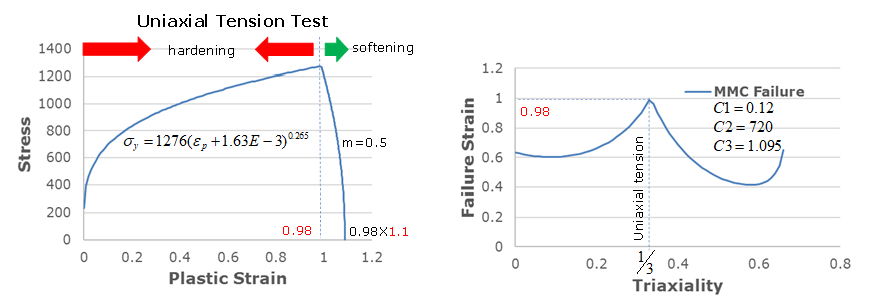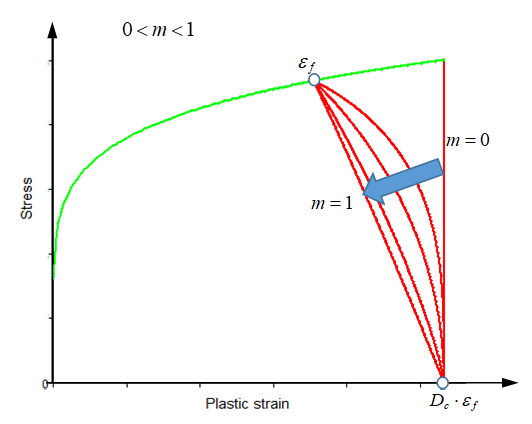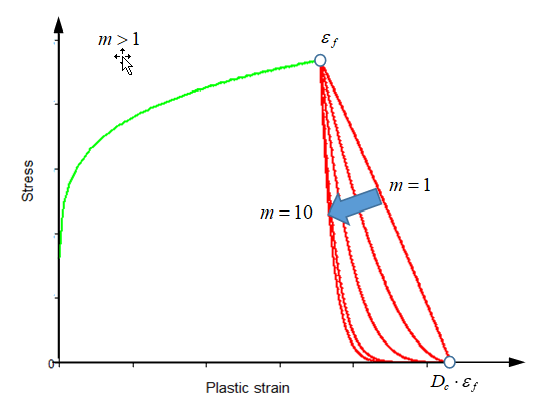/MAT/LAW72 (HILL_MMC)
Block Format Keyword Describes the anisotropic Hill material with a modified Mohr fracture criteria. This law is available for shell and solid.
Format
| (1) | (2) | (3) | (4) | (5) | (6) | (7) | (8) | (9) | (10) |
|---|---|---|---|---|---|---|---|---|---|
| /MAT/LAW72/mat_ID/unit_ID or /MAT/HILL_MMC/mat_ID/unit_ID | |||||||||
| mat_title | |||||||||
| E | v | ||||||||
| n | F | G | |||||||
| H | N | L | M | ||||||
| C1 | C2 | C3 | m | Dc | |||||
Definition
| Field | Contents | SI Unit Example |
|---|---|---|
| mat_ID | Material identifier. (Integer, maximum 10 digits) |
|
| unit_ID | Unit Identifier. (Integer, maximum 10 digits) |
|
| mat_title | Material title. (Character, maximum 100 characters) |
|
| Initial density. (Real) |
||
| E | Initial Young's modulus. (Real) |
|
| v | Poisson's ratio. (Real) |
|
| Initial yield stress. Default = 1020 (Real) |
||
| Initial plastic strain. Default = 10-20 (Real) |
||
| n | Exponent for the isotropic function for the swift hardening:
It is also used as an exponent in the MMC failure equations. 2 Default = 1.0 (Real) |
|
| F, G, H, L, M, N | Six
HILL Materials anisotropic parameters (>
0). (float) |
|
| C1 | First parameter for MMC fracture model. (Real) |
|
| C2 | Second parameter for MMC fracture model. Default = (Real) |
|
| C3 | Third parameter for MMC fracture model. (Real) |
|
| m | Exponent for the softening function. 3 Default = 1.0 (Real) |
|
| Dc | Critical damage.
(Real) |
Example (Metal)

#RADIOSS STARTER
#---1----|----2----|----3----|----4----|----5----|----6----|----7----|----8----|----9----|---10----|
/UNIT/1
unit for mat
g mm ms
#---1----|----2----|----3----|----4----|----5----|----6----|----7----|----8----|----9----|---10----|
#- 2. MATERIALS:
#---1----|----2----|----3----|----4----|----5----|----6----|----7----|----8----|----9----|---10----|
/MAT/LAW72/1/1
Metal
# RHO_I
0.0028
# E nu
200E+3 0.3
# Sig0 Eps0 n F G
1276 1.63E-3 0.265 0.5 0.5
# H N L M
0.5 1.5 0 0
# C1 C2 C3 m Dc
0.12 720 1.095 0.5 1.1
#---1----|----2----|----3----|----4----|----5----|----6----|----7----|----8----|----9----|---10----|
#ENDDATA
/END
#---1----|----2----|----3----|----4----|----5----|----6----|----7----|----8----|----9----|---10----|
Comments
- 3D equivalent Hill
stress:
For shell element, take:
- MMC fracture
criteria:With
- For 3D solid elements
is stress triaxiality with
is shift Lode angle
with Lode angle ( ) parameter
is the third invariant of the deviatoric stress.
- For shell elements
is stress triaxiality with
is shift Lode angle
with Lode angle ( ) parameter
- For 3D solid elements
- Fracture and damage with MMC
fracture criteria:
- When D = 1: fracture initiate
- By 1 < D <
Dc: the yield stress is multiplied
by softening function
to reduce the deformation resistance.
with
- If D ≥ Dc, the element is deleted.
- The exponent m is used to describe the softening behavior. It is
recommended to use m > 0.
If 0 < m < 1, then the softening curve is convex.
If m > 1, then the softening curve is concave. The softening is between and . Once the plastic strain is reached (in this case ), then the element is deleted.Figure 2. 
Figure 3. 
- It is possible to display user
variables in animation files (with Engine /ANIM/Eltyp/Restype) and in Time history file (with Starter /TH/SHEL and /TH/BRIC):
- USER1: Damage value
- It is also possible to display a normalized damage variable in animation files with /ANIM/BRICK/DAMG, /ANIM/SHELL/DAMG, /H3D/SHELL/DAMG and /H3D/SOLID/DAMG.